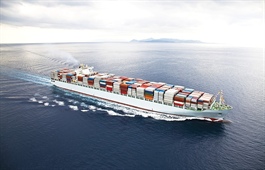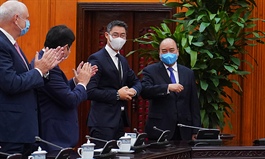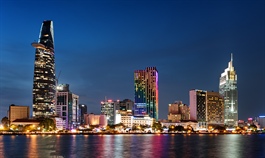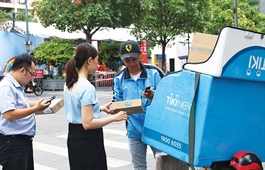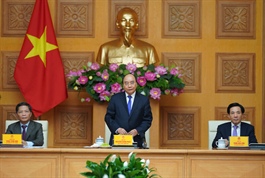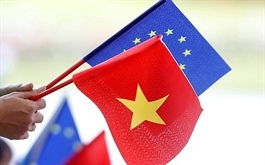What makes Ho Chi Minh City enduringly endearing
What makes Ho Chi Minh City enduringly endearing
Through all the momentous changes that have happened down the years – from cityscape to mindsets – HCMC somehow retains its beguiling charm.
My first recollection of HCMC is being propelled feet first on a cyclo into the dazzling glare of an afternoon sun. Hemmed in by motorbikes with no sense of self-preservation, after the initial disbelief, I simply melted into the melee.
That set the tone for what was to come. Inexplicably mesmerized, I went with the city’s flow – literally.
Flying in from snowy London in 1998 as an "intrepid" backpacker, I was seduced instantly by the broad sunny smiles, sultry tropical climes, pulsating street life and palpable energy.
Thus commenced an all-consuming love affair with Vietnam, especially HCMC.
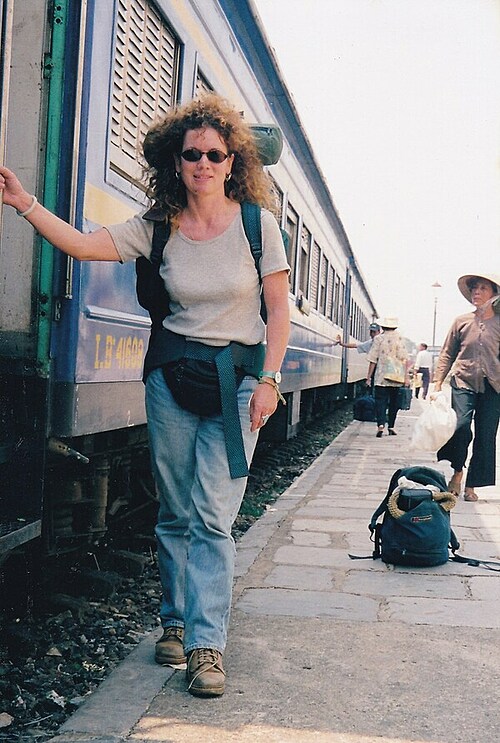
Samantha Coomber is at Saigon train station, 1998. Photo courtesy of Samantha Coomber.
|
During the initial trip and repeat stays until 2002, HCMC was, in parts, a different world. It was like walking into the pages of Graham Greene’s ‘The Quiet American.’ For me, the city still lived up to the ‘Paris of the Orient’ legend – the cyclos and push bikes, white ao dai fluttering in the breeze, dreamy French Indochina-era buildings and tree-lined boulevards.
It was a voyage of discovery – of ca phe sua da and local street food, com tam and pho ga shops and sizzling banh xeo; and it was a blending in – watching swarms of Saigonese, on balmy weekend evenings, slowly cruise downtown on their motorbikes – "di hong gio" – and participating in the ritual myself.
Then there were the lingering legacies of wartime Saigon, from Dan Sinh Market's U.S. army memorabilia to the notorious nightlife, most notably the Apocalypse Now club bedecked with sandbags and chopper blades - evocative scenes that inspired me to write feverishly about this city’s allures.
Asia’s hot new city
After living in Hanoi for several years, I headed south to where it was all happening – HCMC – in 2006. Evidently, it was the ‘right time, right place’ to be. As Vietnam enjoyed unprecedented growth, it was boom time for the nation’s economic powerhouse. Ranked the developing world’s second fastest growing city, HCMC saw frenzied investment and transformation fueled by a dogged desire to play catch-up with its Asian neighbors.
Relatively intact during wartime, HCMC ironically experienced mammoth changes in peace time.
The city skyline shot upwards with glass-encased high-rise hotels, offices and apartments. Century-old colonial and heritage buildings were torn down, sometimes entire blocks. As Vietnam prioritized economic development, the pace at which urban parks and gardens were disappearing had picked up.
This had allegedly been happening since 1975, but the decade from 1998 was when half the city’s green spaces got swallowed up by an expanding concrete jungle comprising residential, commercial and public projects. The construction extended to outer districts like District 7, where an exclusive new residential zone sprang up from swamps and paddy fields, heralded as the new face of 21st century HCMC.
Developing at warp speed, the city emerged as an increasingly cosmopolitan metropolis, with sophisticated venues opening in rapid succession: cocktail bars, stylish new cafés, hip nightspots and hotels like the Sheraton Saigon Hotel & Towers and Park Hyatt Saigon ushering in a new level of world-class accommodations, spas and fine dining. Earmarked as ‘the new Orchard Road,’ luxury international labels muscled in on historic Dong Khoi Street, including the game changer, the Louis Vuitton flagship.
Another new addition on Dong Khoi, the Vincom Center, inaugurated in 2010, trail-blazed a new generation of upscale shopping malls, retailing high-end global brands. Built on the site of a sleepy art gallery-cum-café I once frequented, this ultra-modern, glass-fronted high-rise descending into subterranean levels symbolized the scale of the city’s transformation.
‘Old Saigon’ was eroding before my eyes at an alarming rate, but I was also happy to acquaint curious international editors – some still perceiving Vietnam as a war-ravaged nation – with all these exciting additions (including the glut of new five-star resorts along the southern coastline) that catapulted ‘Asia’s hot new city’ onto the global stage.
While I prepared to relocate in late 2010, the Bitexco Financial Tower officially launched; at 262m (861ft)-high, Vietnam’s then tallest building boasted the nation’s first helipad and ranked by CNN as one of the world’s top 25 iconic skyscrapers.
By the time I flew out of the airport’s impressive new international terminal, I’d grown weary of the escalating noise levels and relentless construction.
Alarming meets reassuring
Each time HCMC pulled me back, I observed new evidence of "progress."
However, it was only after relocating back for work in April 2018 after an eight-year absence that I noticed the most dramatic changes, not just in the cityscape, but in the Saigonese mindset and lifestyle.
It started with the airport drive: taking less than 20 minutes in 1998, it now took at least double that. The motorbike traffic was still insane, but now swelled with hitherto unseen Grab and Gojek taxis and oversized foreign cars – including SUVs and the odd Porsche. The ‘city on the move’ had spluttered into a network of gridlocks.
Although the dust has settled somewhat on the frenzied urbanization drive, many irreplaceable colonial buildings have been demolished and more are under threat. The badly-needed metro project, started years ago, now blights charming downtown boulevards with an ugly construction site where familiar old buildings like the Saigon Tax Trade Center once stood.
Conversely, Nguyen Hue has been transformed into a central pedestrian zone, a popular evening gathering point complete with a lotus fountain spouting a musical light show, flanked by neon-lit high-rises including the 39-story Times Square Building – home to the outrageously opulent hotel, The Reverie Saigon.
I was reassured, however, to see familiar landmarks like the Rex Hotel and the majestic Hôtel de Ville also in the backdrop.
After decades of foiled attempts, Western icons Starbucks and McDonalds have finally infiltrated Vietnam; one branch of the latter, bizarrely juxta-positioned next to the ‘grand dame’ Central Post Office. The public ferry service across the Saigon River had been replaced with cutting-edge bridges and one of the most polluted, uninhabitable city canals, Nhieu Loc-Thi Nghe, had been successfully redeveloped as a 10 km (6 mi)-long, residential scenic waterway, following the completion of an ambitious, two-decade urban project.
From communal Internet cafés, the city has moved to smartphone addiction and omnipresent Wi-Fi access – even in hole-in-the-wall eateries. The Saigonese youth are more digitally savvy than me, deftly ordering food and services off apps as par for the course. The moneyed classes appear to have more disposable income, refined tastes and consumerist fervor, epitomized in an explosion of new luxury shopping malls across the city. My jaw dropped when I first visited the glitziest of them all, Takashimaya Saigon Center, a palatial golden tower showcasing renowned brands like Kenzo and Versace.
And when I discovered that high-street retail giants Zara and H&M had launched their chic flagships at the Vincom Center, I knew HCMC had ‘arrived.’
Beyond downtown, I was stunned at the clumps of soaring tower blocks, noticeably en route to District 4 and in District 2. But it is Binh Thanh’s dazzling night-time backdrop along the Saigon River’s western banks that took my breath away, Landmark 81 in particular. The 81-story, upscale residential and commercial skyscraper, Vietnam’s tallest, surrounded by the exclusive high-rise apartments of Vinhomes Central Park, symbolizes HCMC’s – and Vietnam’s – progress and prosperity. Illuminated post-dusk with zillions of twinkly white lights, I have to admit, with some reluctance, that Landmark 81 is the most stunning modern-era building I’ve ever seen.
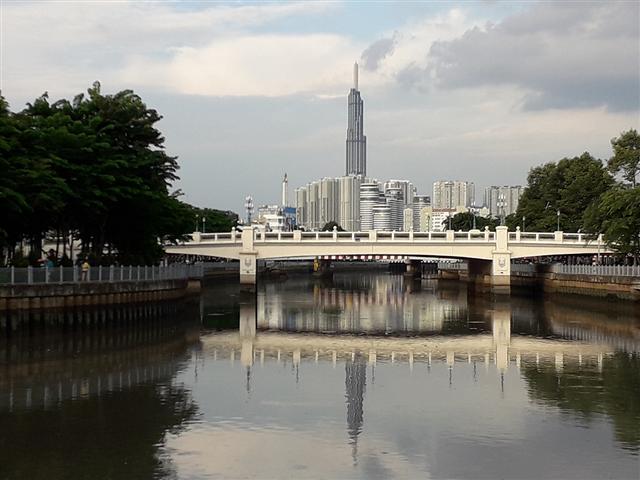
Views of Landmark 81 and Vinhomes Central Park from Nhieu Loc-Thi Nghe Canal in Binh Thanh District, HCMC, 2020. Photo by Samantha Coomber.
|
Timeless pockets
As a foreigner and temporary resident, like many visitors, I’m guilty of still expecting an "unspoilt" scenario and dragging my feet in lauding Saigon’s progress. But I, we, can’t selfishly impede the inevitable march of time and globalization. Others have a different agenda and who am I – are we – to begrudge them their success amid a socio-economic renaissance?
However, amid the glitzy high-rises and rooftop bars, there are still innumerable pockets where the "old" Saigon street life and traditions hold sway. You just have to look a bit harder. Even in District One, there are old school street-side cafés, narrow hem (alleys) where communal life nestles along boulevards like Ham Nghi and Dong Khoi.
There are still local neighborhoods like Tan Dinh and Chinatown (Cho Lon), where, with my shock of blonde curls, I’m still greeted by open-mouthed kids and excited squeals of "Hello! Hello!" Amid massive redevelopment, in some quarters, Cho Lon still retains its shophouses, 18th century pagodas and a tangible air of 1950s Chinatown.
Life adapts. Although western fast food culture has been enthusiastically embraced, Saigon still clings to its world-leading culinary traditions. Families still flock to open-air barbecue joints for dinner and despite the cumbersome metro site, the "di hong gio" ritual still continues. Post-dawn and pre-dusk, scores of Saigonese gravitate to the remaining green spaces to exercise. And while I have to learn to live with increasingly intolerable noise levels, I am also grateful for the city’s timeless pockets.
My love affair with Ho Chi Minh City endures.
*Samantha Coomber is a British freelance travel and lifestyle writer, who has lived in Ho Chi Minh City for seven years and written about it for 22 years. She has contributed to several Vietnam travel guides and is the author of "Insight Guides on Hanoi & HCMC." The opinions expressed are her own.




